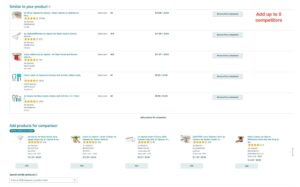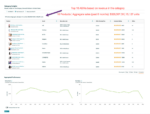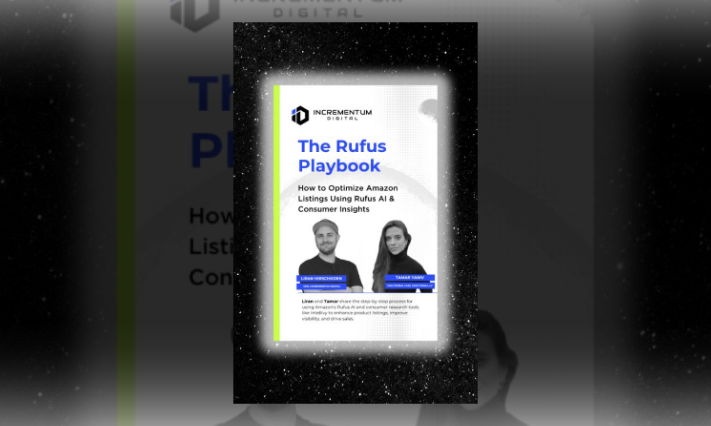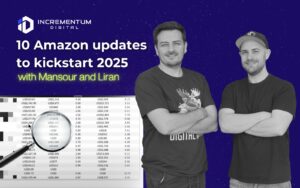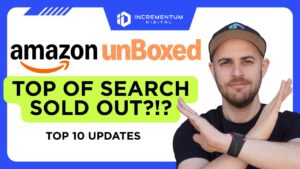Amazon Advertising
Amazon Ads Updates for June 2025: Smart Advertising Strategies, the Rise of AI and Creator Content
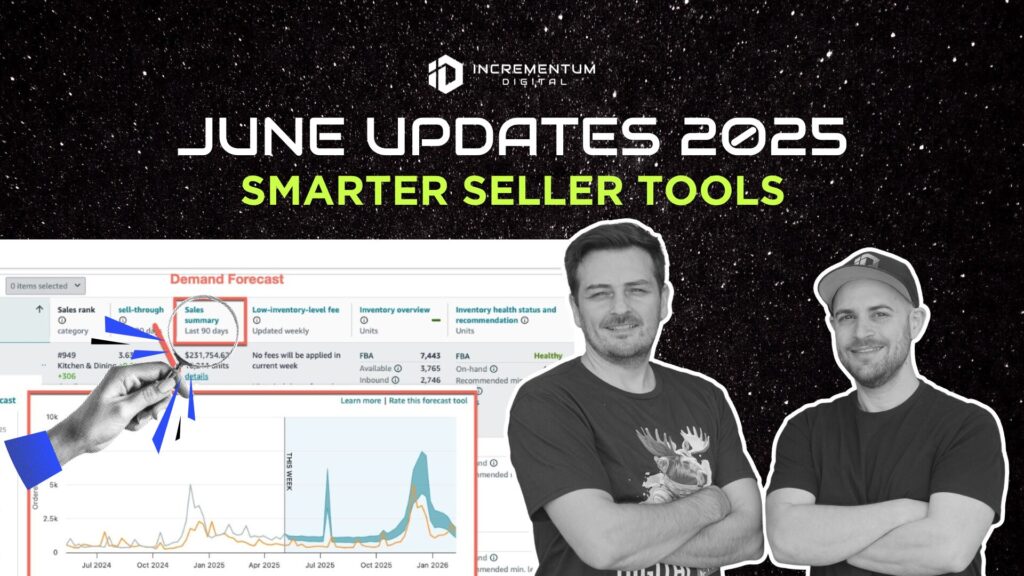
Liran and Mansour just broke down the latest Amazon ads updates for June 2025, and there’s a lot you’ll want to know. From new Amazon advertising strategies with forecasting tools and pricing insights to changes in how Prime Day works, these updates are built to help sellers stay sharp. Here’s why it matters: better prep for Prime Day, more visibility for your products, and smarter decisions across the board.
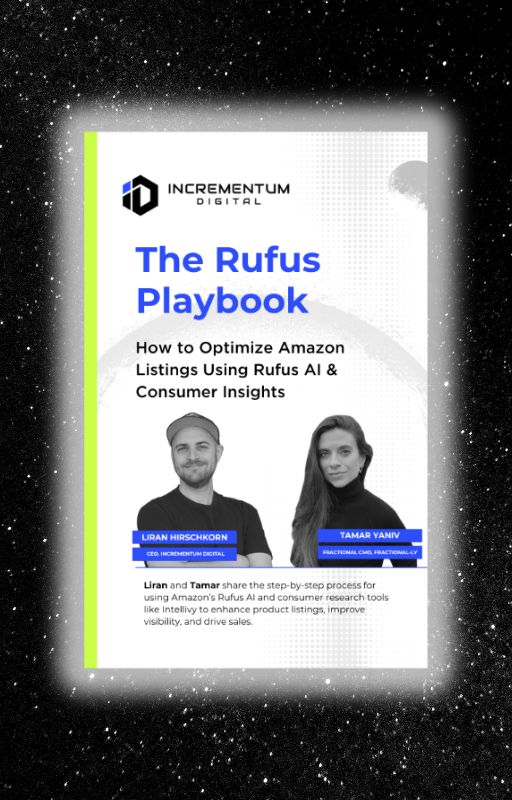
Learn How to Make Listings That Convert in 2025!
Read our step-by-step guide on how to optimize your listings using Rufus AI insights. Sign up for our newsletter and get your copy for free!
Show me howUpdate #1: Amazon Prime Day 2025 Expands to 4 Days
Amazon Prime Day 2025 is officially set for July 8 to 11, turning what was once a 48-hour sprint into a four-day sales window. More time on the calendar means more potential to scale, but only if you approach it with the right strategy.
Here’s how to break it down:
- Pre-Prime Day (July 5 to 7): This is when shoppers are researching, browsing, and adding to cart. Slightly increase budgets for products with scheduled deals. For ASINs without deals, consider dialing back to avoid inefficient spend.
- Day 1 (July 8): Expect this to be the highest performing day. Push hard on budget and bids for deal ASINs and top performers.
- Day 2 (July 9): Performance usually stays strong but may taper slightly. Monitor closely and adjust budgets based on real-time results.
- Days 3 and 4 (July 10 to 11): These days are less predictable. Some customers may return for items they missed or revisit carts. Use performance data to decide whether to sustain or scale down.
Recommendation: Retarget aggressively after Prime Day. That surge of traffic is valuable, especially for consumables and repeat buys. Make sure your inventory and ad budgets are set to support the full stretch of activity.
Update #2: Demand Forecasting Gets Smarter
Amazon has added a new demand forecasting feature to the FBA inventory dashboard that gives you a much clearer view of where your sales are headed.
You can now access up to 40 weeks of historical data and overlay it with Amazon’s predictive models. The default view shows four weeks, but you can expand it to see longer trends and seasonal patterns.
This tool is especially useful for:
- Inventory planning based on actual sales trends
- Promotion timing and aligning discounts with expected demand
- Prime Day prep, using last year’s data to anticipate volume spikes
You’ll find it under Sales Summary > Detail in the FBA inventory section. It’s a simple graph for now, but already a powerful asset for staying ahead of demand and avoiding stockouts or overstock.
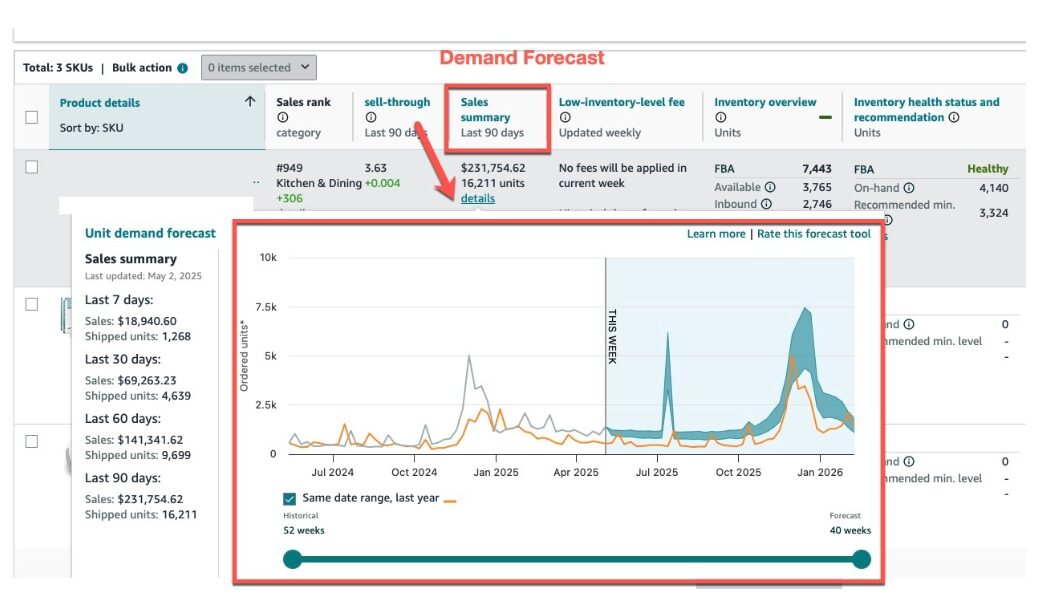
A look inside Amazon’s new Demand Forecasting tool, showing historical sales, last year’s trends, and projected demand—all in one view to support smarter inventory and advertising decisions.
Update #3: Competitor Price Comparison from Your Dashboard
Amazon now lets you compare your product pricing directly against up to five competitor ASINs, right from the inventory dashboard.
You can see:
- Minimum and median prices across the selected competitors
- Each ASIN’s sales rank
- A quick option to match pricing if needed
This tool gives you a faster, clearer view of where you stand in the market. It helps you make informed pricing decisions without blindly slashing prices or chasing a race to the bottom. For brands that want to stay competitive while protecting margins, this is a key update to start using now.
- See how your pricing stacks up against up to five competitor ASINs directly in the All Inventory dashboard, including minimum and median prices to guide smarter pricing decisions.
- Select and compare up to five competing ASINs to analyze their pricing, sales rank, and offers—all within a single view to support strategic pricing decisions.
Update #4: Custom ASIN-Level Performance Alerts
You can now set up custom performance alerts for your ASINs directly within your business reports. This feature lets you monitor what matters most and respond quickly when something changes.
Here’s how it works:
- Create up to 5 alert groups
- Track up to 10 ASINs per group
- Set conditions for metrics like sales, units ordered, page views, and buy box percentage
- Choose to track changes daily, weekly, or monthly
- Get automatic email alerts when your set conditions are met
This is a simple but powerful way to catch performance shifts early and make timely decisions without needing to check your reports constantly.
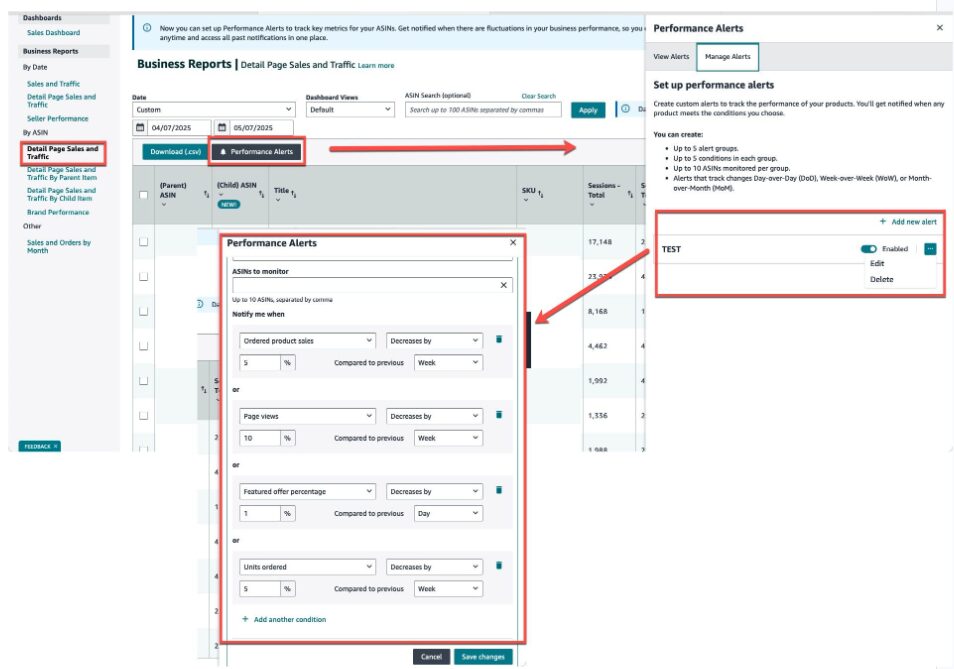
Set up custom performance alerts for key ASIN metrics like sales, page views, and buy box percentage—get notified automatically when performance shifts.
Update #5: Inventory Alerts Based on Sell-Through
Amazon now lets you set inventory alerts based on your recent sell-through rate, helping you manage stock levels with more accuracy.
You can define a threshold like 8 weeks of coverage, and Amazon will alert you when your inventory drops below that level. The system calculates coverage based on your past 30 days of sales velocity, making the alert relevant to your current pace.
This helps you:
- Avoid unexpected stockouts
- Plan reorders with more confidence
- Stay ahead of Prime Day or seasonal surges
You’ll find this under the FBA inventory view by clicking the three-dot menu next to each product.
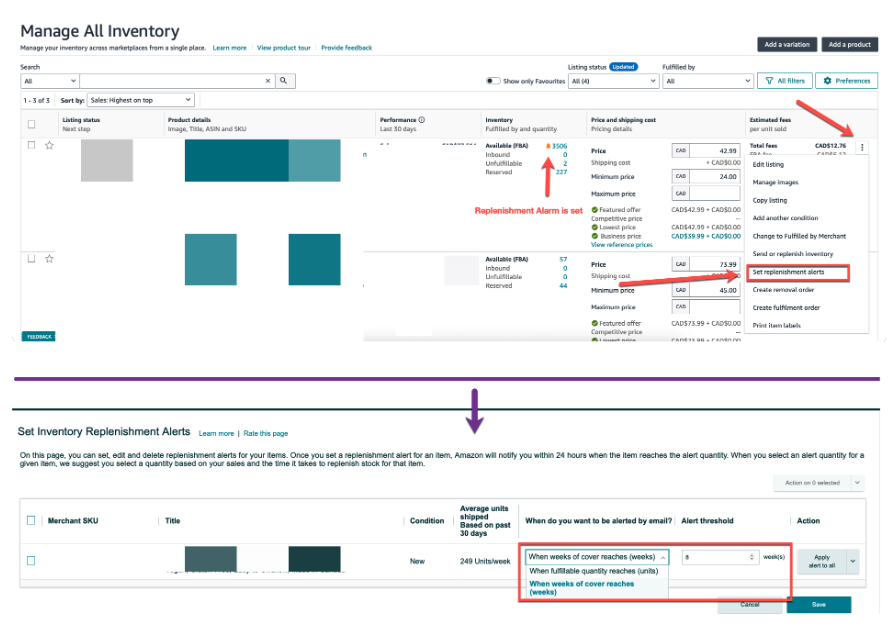
Set custom inventory replenishment alerts based on units sold or weeks of coverage—Amazon will notify you when stock drops below your set threshold using real sales velocity data.
Update #6: Demographic Insights Now Available at ASIN Level
Amazon has expanded its demographic reporting to the ASIN level, giving you a more detailed view of who is actually buying each product.
You can now drill down into buyer data like:
- Age
- Gender
- Household income
- Education level
- Marital status
This is especially useful for fine-tuning your creative, messaging, and audience targeting. Instead of making assumptions based on brand-level data, you can shape strategy around the real buyer profile for each ASIN.
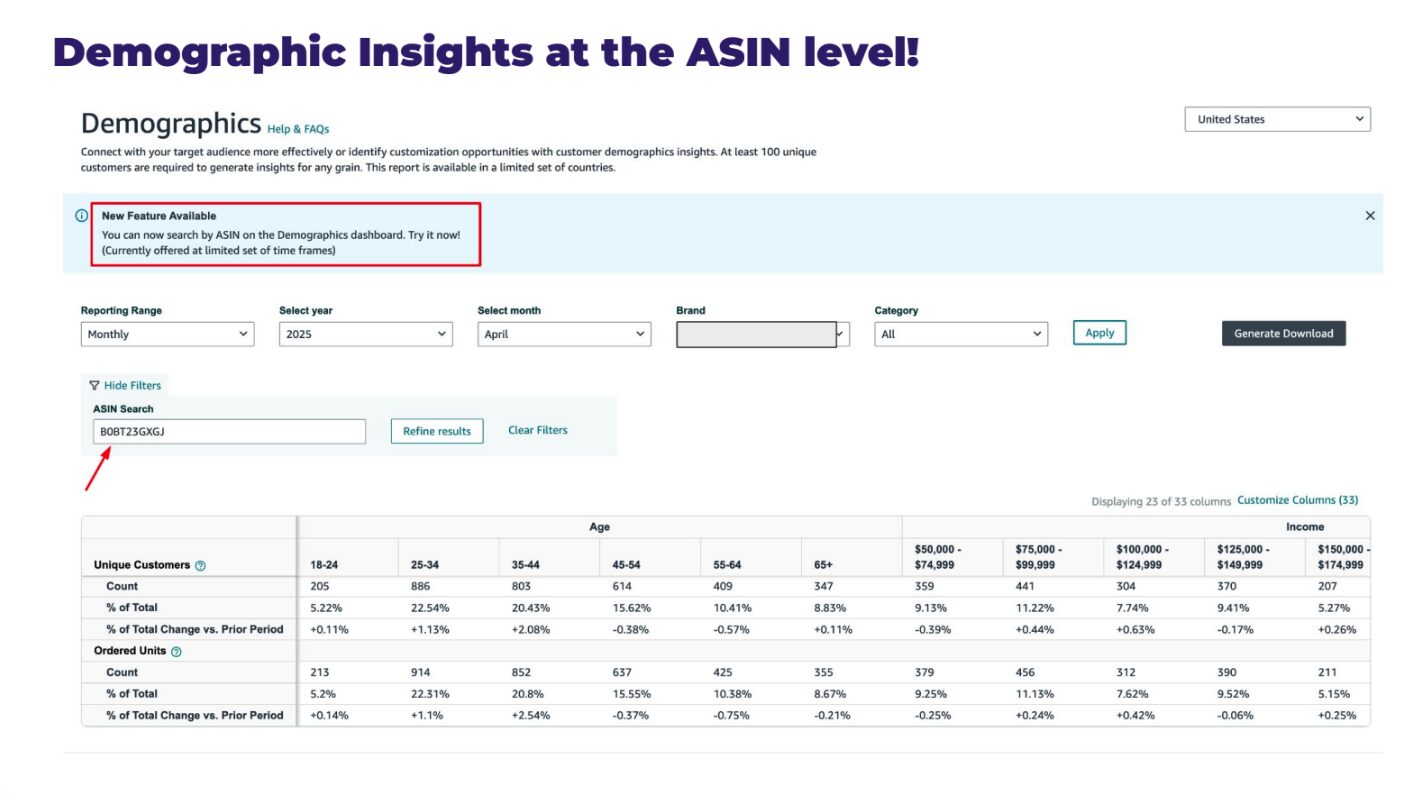
Amazon’s updated Demographics dashboard now allows you to filter insights by individual ASINs, providing a detailed breakdown of customer attributes like age, income, and purchase behavior—critical for refining product-level marketing and targeting strategies.
Update #7: Amazon Category Insights Adds Top & New Product Data
Amazon’s Category Insights dashboard just got more powerful. You can now view top-grossing and newly launched ASINs within your category, complete with detailed performance data.
This includes:
- Total revenue and units sold
- Return rates
- Sales trends over 30, 90, and 365 days
It’s an excellent tool for benchmarking your products, identifying market leaders, and spotting new competitors. If you’re planning a launch or evaluating category performance, this is a must-use feature.
- Explore category performance by top-grossing and newly launched ASINs to uncover market trends, sales volume, and new product opportunities within your niche.
- View the top 10 ASINs in your category ranked by revenue, including aggregated sales, unit volume, pricing, and customer ratings—perfect for competitive benchmarking and spotting category trends.
Update #8: Amazon Posts Are Being Sunset
Amazon is phasing out Posts and shifting focus to Creator Connections, which centers around influencer-style video content with shoppable placements.
Instead of static brand content, the platform is moving toward creator-driven videos that can appear on product detail pages, in search, and across the Amazon app. These creators can earn commissions when their content drives purchases.
This opens up new opportunities for both on-Amazon exposure and off-Amazon reach, especially if you’re already working with influencers or plan to. It’s a shift worth leaning into as brand visibility becomes more content-driven.
Update #9: New Storefront Product Selector Tool
Amazon has introduced a Product Selector feature that lets you build a quiz-style experience directly into your Store.
You can create up to six questions, each with multiple answer options. Based on how shoppers respond, Amazon will show them relevant product recommendations from your catalog.
This is a great tool for:
- Gift guides
- Bundled product suggestions
- Helping shoppers navigate large catalogs
It’s simple to set up and can drive more engagement by making the shopping experience more personalized and interactive.
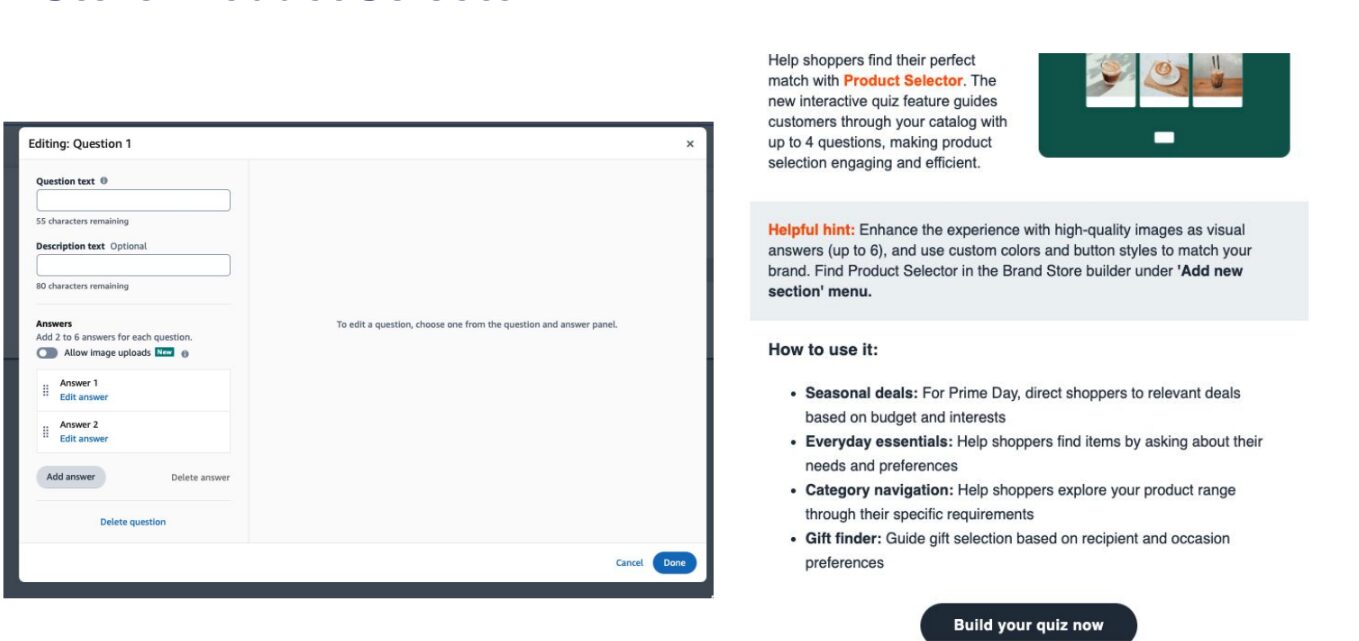
Turn decision fatigue into confident clicks: This tool has potential for helping shoppers choose the right flavor, color, style, or bundle.
Update #10: Audience Segments for Deals (Early Stages)
Amazon has started rolling out audience targeting options within the deal creation flow. Right now, it’s limited to basic filters like Prime members or all customers, but it signals the start of something bigger.
This could evolve into more advanced targeting similar to what we see in Amazon Marketing Cloud, such as:
- New-to-brand shoppers
- Cart abandoners
- Repeat buyers
While the current functionality is limited, it’s worth keeping an eye on. As it expands, it could open up much more precise control over who sees your deals.
Update #11: AI-Generated Video Builder in Ads Console
Amazon has launched a new AI-powered video builder inside the Sponsored Brand creative tools. It automatically creates short videos using your product images and a set of basic templates.
The features are still early stage with limited customization and simple transitions, but it signals a clear shift toward automated ad creative. As the tool develops, we expect to see more flexibility in scene selection and storytelling options, making it easier to produce video content quickly at scale.
Mansour shared a detailed walkthrough of how it works in his LinkedIn post, including a live demo using Zesty Paws as an example. It’s worth checking out to see what the tool looks like in action.
Key Takeaways for Brands and Advertisers
- Fine-tune your Amazon Prime Day 2025 strategy now. With four full days of high traffic starting July 8, make sure your budgets, bids, and inventory are aligned and ready to scale.
- Leverage Amazon’s newest tools to stay sharp. Use forecasting to manage inventory, pricing comparisons to stay competitive, and performance alerts to respond quickly to changes.
- Use category insights to benchmark performance. Identify top sellers and spot trends or gaps in your category using the upgraded dashboard.
- Shift focus to creator and video content. With Amazon Posts being phased out, now is the time to explore Creator Connections and build out shoppable video strategies.
- Try the Product Selector tool if you have a large catalog. It creates a guided, quiz-like shopping experience directly in your Store.
- Watch how audience targeting evolves. The new segmentation features in deals are basic for now, but could open the door to much more refined targeting.
- Test AI-generated videos. They’re simple but fast, and a great way to add Sponsored Brand video without a full production workflow.
Watch the Full Walkthrough
Want to see everything in action? Liran and Mansour break down all 11 updates in our latest monthly video, with real examples and strategy tips for each one:
LET’S DISCOVER WHAT’S POSSIBLE FOR YOUR BRAND
We’re here to listen and uncover opportunities tailored to your unique goals.
Fill out the form to get started, and you’ll walk away with real insights and actionable recommendations—whether we work together or not.
- HANDS-ON LEADERSHIP
- AWARD-WINNING PARTNERSHIPS
- CUSTOM-BUILT SOLUTIONS

